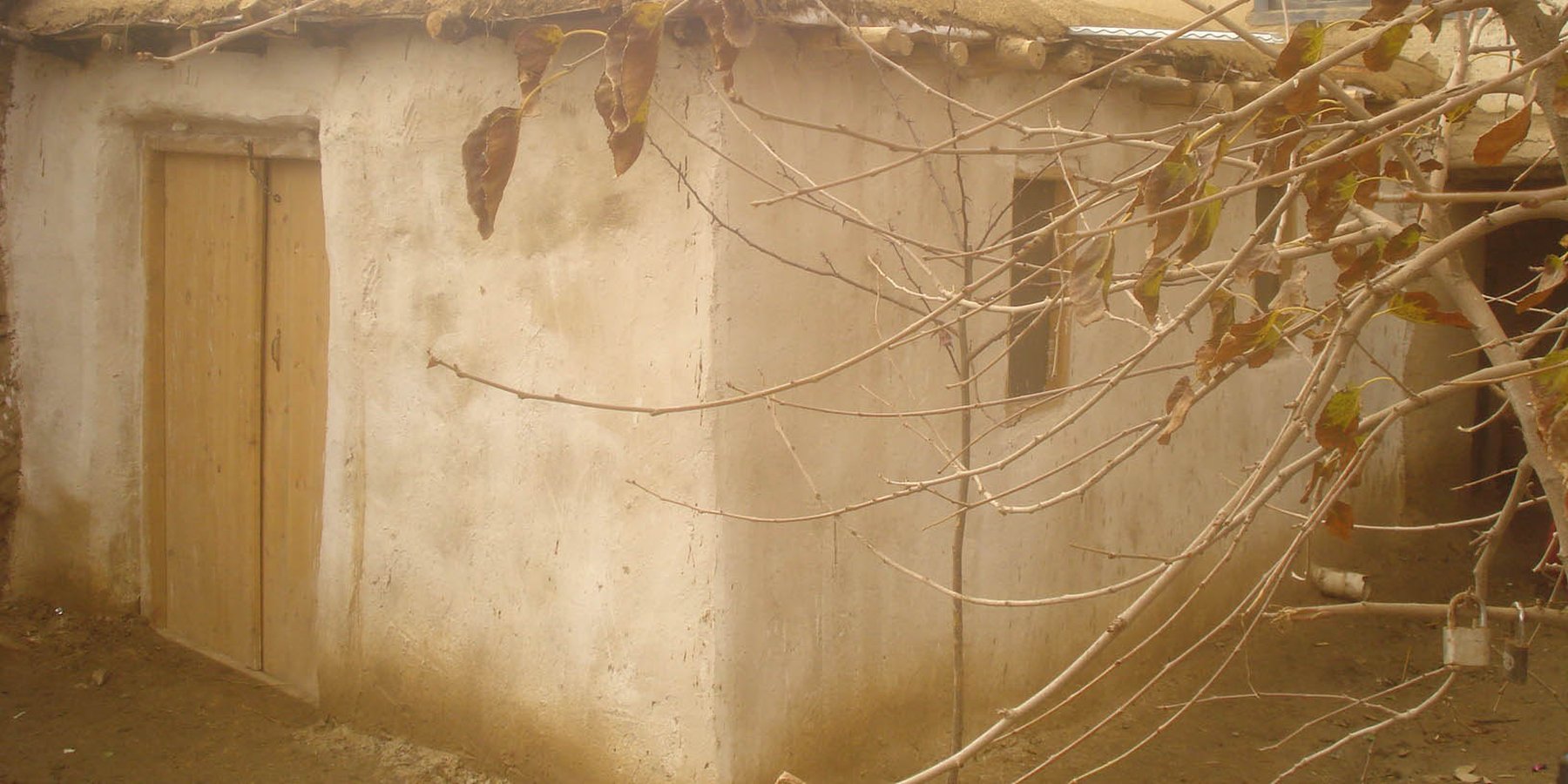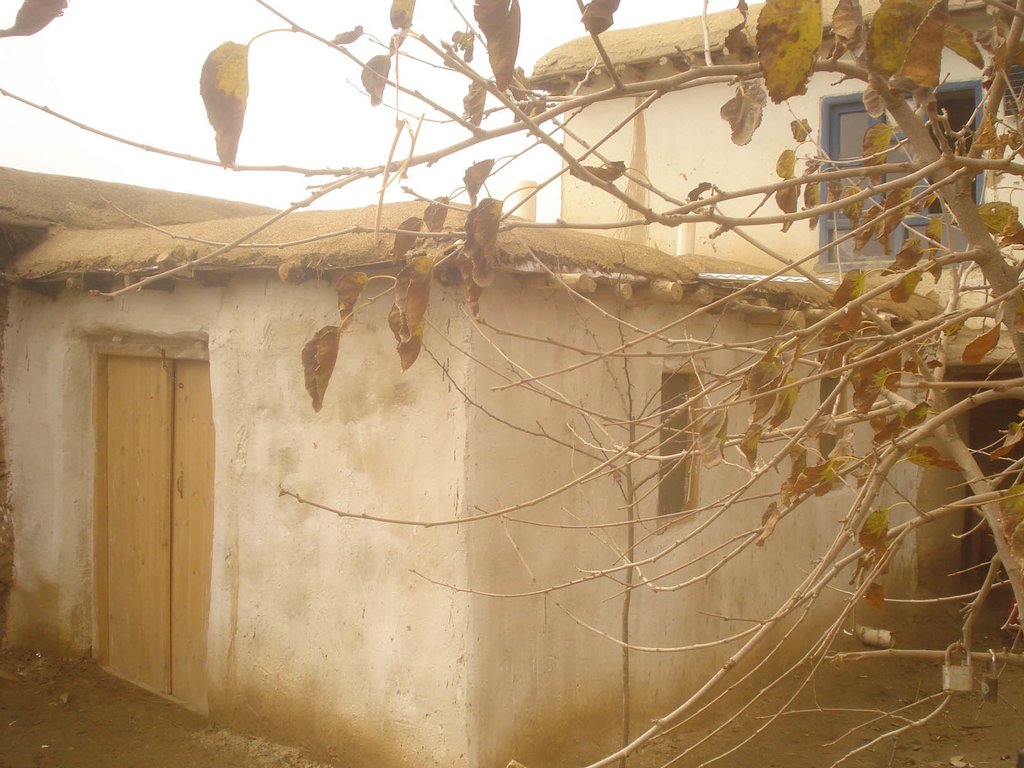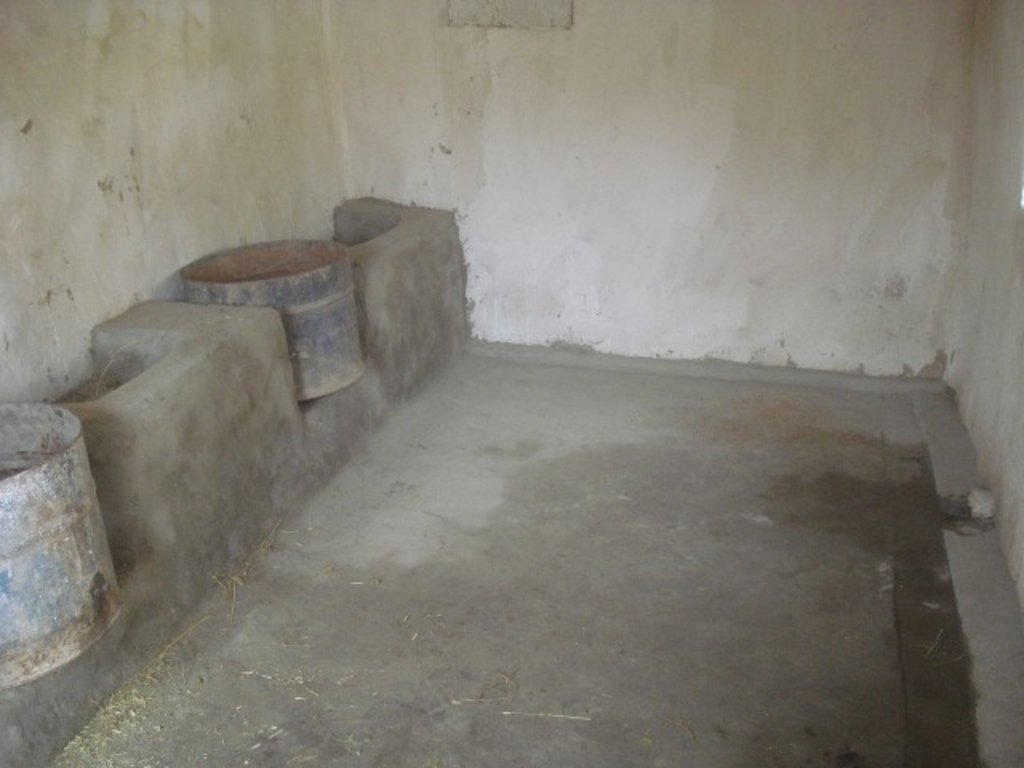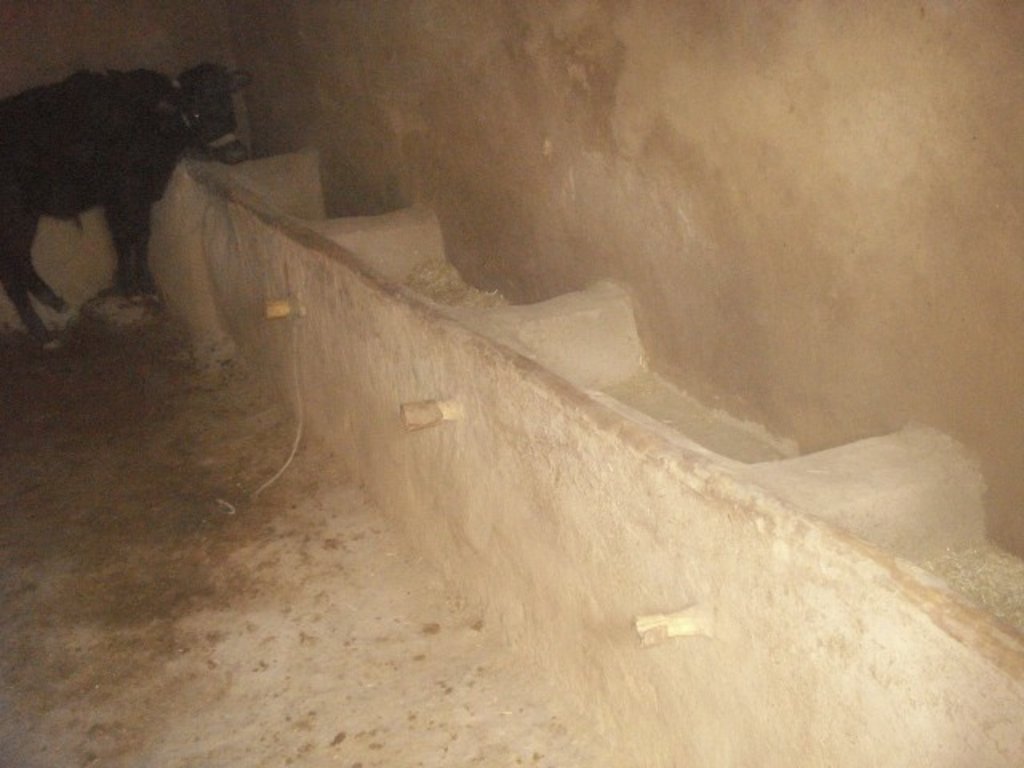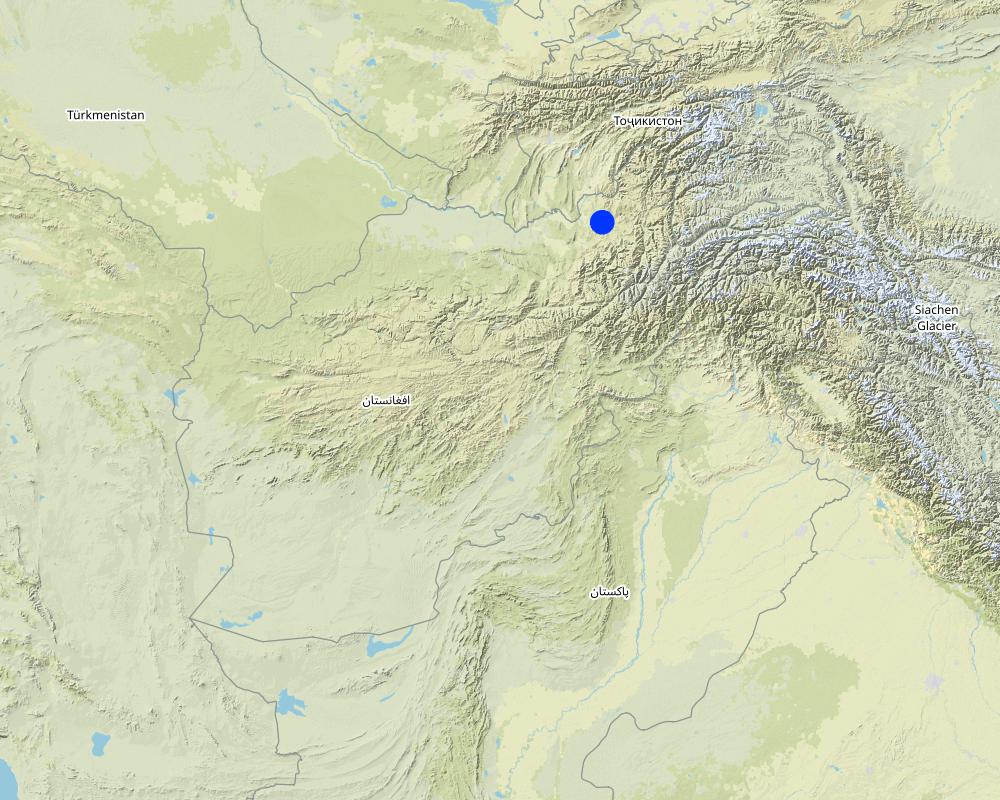Improved livestock shed for better health and productivity [Afganistán]
- Creación:
- Actualización:
- Compilador: Bettina Wolfgramm
- Editores: Miajan Maroofi, Hekmatullah Sharifzai, Roziya Kirgizbekova, Aslam Qadamov
- Revisor: William Critchley
Tabela; Oghil
technologies_673 - Afganistán
Visualizar secciones
Expandir todo Colapsar todos1. Información general
1.2 Detalles de contacto de las personas de referencia e instituciones involucradas en la evaluación y la documentación de la Tecnología
Researcher:
usuario de la tierra:
Alti Boy Sherogha
Natural Resources Management Committee (NRMC)
Sari Joy village, Rustaq District
Afganistán
Nombre del proyecto que financió la documentación/ evaluación de la Tecnología (si fuera relevante)
Livelihood Improvement Project Takhar, Afghanistan (LIPT)Nombre del proyecto que financió la documentación/ evaluación de la Tecnología (si fuera relevante)
Potential and limitations for improved natural resource management (NRM) in mountain communities in the Rustaq district, Afghanistan (Rustaq NRM Study)Nombre de la(s) institución(es) que facilitaron la documentación/ evaluación de la Tecnología (si fuera relevante)
Terre des Hommes (Terre des Hommes) - SuizaNombre de la(s) institución(es) que facilitaron la documentación/ evaluación de la Tecnología (si fuera relevante)
Swiss Agency for Development and Cooperation (DEZA / COSUDE / DDC / SDC) - SuizaNombre de la(s) institución(es) que facilitaron la documentación/ evaluación de la Tecnología (si fuera relevante)
CDE Centre for Development and Environment (CDE Centre for Development and Environment) - Suiza1.3 Condiciones referidas al uso de datos documentados mediante WOCAT
El compilador y la/s persona(s) de referencia claves aceptan las condiciones acerca del uso de los datos documentados mediante WOCAT:
Sí
1.4 Declaración de la sostenibilidad de la Tecnología descrita
¿La Tecnología aquí descrita resulta problemática en relación a la degradación de la tierra, de tal forma que no puede considerársela una tecnología sostenible para el manejo de la tierra?
No
Comentarios:
SLM practices documented in the frame of the Rustaq NRM study were established only recently (1-3 years ago). It is too early for a final judgment on the sustainability of these technologies within the human and natural environment of Chokar watershed.
1.5 Referencia al (los) Cuestionario(s) de Enfoques MST
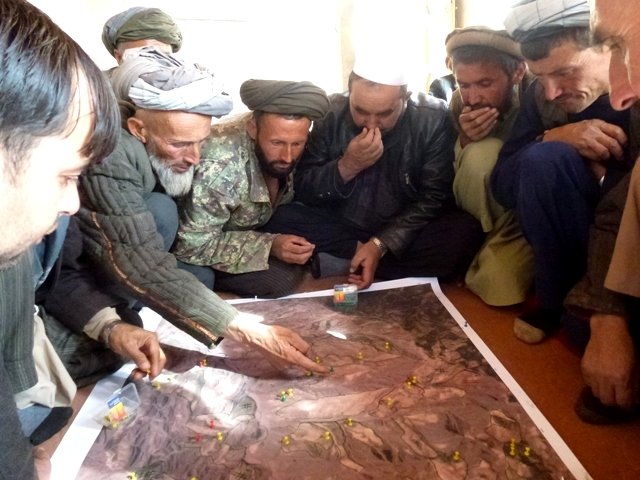
Watershed Associations (WSA) and Natural Resource Management Committees … [Afganistán]
Two Watershed Associations (WSA), in Chaker and Nahristan watershed areas respectively, are registered at the national level with the Ministry of Agriculture Irrigation and Livestock (MAIL) and at the regional level with the Department of Agriculture. Both associations are strong, active, dynamic, and have the capacity to coordinate and support …
- Compilador: Bettina Wolfgramm
2. Descripción de la Tecnología MST
2.1 Breve descripción de la Tecnología
Definición de la Tecnología:
Existing livestock sheds can be improved through interior and exterior refurbishing, and door and window installation. More favourable indoor conditions benefit animal health and the quality of animal products.
2.2 Descripción detallada de la Tecnología
Descripción:
Livestock keeping is one of the key livelihood strategies in rural Rustaq - in addition to cultivation of agricultural crops. Families rely on their livestock not only for consumption of meat and dairy products, but also as means of transportation (donkeys), labour force in agriculture (oxen, donkeys) and as a source of cash income. When crops fail to produce enough, families sell their livestock to survive until the next season. The pressure to sell livestock is more acute during winter months, when cases of livestock loss increases - from diseases, lack of fodder and the harsh cold winter. These factors, along with poor conditions for livestock keeping, expose the animals to various negative impacts, affecting health, productivity and low quality/ quantity of meat and milk.
This situation is observed mainly in Sari Joy, Jawaz Khana and Dashti Mirzai villages, although Dasthi Mirzai has limited grazing land and livestock keeping is not as prevalent as in the two other villages. All three villages were selected to demonstrate improved livestock sheds, which are among the key factors for productive livestock keeping, along with stable supplies of quality fodder. Improved livestock sheds are part of the chain of activities introduced in the three villages to support livestock production, and at the same time improve the availability and quality of fodder, and restore the degraded and overgrazed pastures.
The Natural Resources Management Committee in the respective villages select a farmer, who is active in livestock keeping and already has a livestock shed. The farmer agrees to provide his livestock shed to serve as a demonstration. The farmer is supported technically and financially to renovate his shed in accordance with the defined requirements. The internal and external walls of the shed are covered with plaster made from a clay mixture to block all holes and protect the building from wind and rain. The roof is renovated to prevent leaking from snow and rain. Windows, a door and a ventilator are installed to ensure air circulation, decrease humidity levels, and protect the animals from cold and heat. A water trough and feeding racks are installed inside the shed. All the costs for the material are covered by the project. The farmer contributes with his labour.
The improved shed is vital for keeping livestock healthy. It also contributes to lowering livestock loss through decreasing the risks of diseases and cold stress during winter. The overall benefit towards livelihoods is significant, since animals are an important household asset and a coping strategy for the majority of households in the villages. The wives of the farmers benefit particularly from the renovated livestock sheds, because they are the ones who feed and water the animals, and they clean the shed of manure.
However, the costs for carrying out renovation of livestock sheds are perceived too high by the farmers. Many are unwilling to make such investments, despite the benefits.
2.3 Fotografías de la Tecnología
2.5 País/ región/ lugares donde la Tecnología fue aplicada y que se hallan comprendidos por esta evaluación
País:
Afganistán
Región/ Estado/ Provincia:
Takhar Province, Rustaq District
Especifique más el lugar :
Sari Joy, Jawaz Khana, Dashti Mirzai villages
Comentarios:
Coordinates of SLM plots owned by SLM implementers who participated in the FGD derived through the Rustaq NRM study QGIS database.
This documentation is based on the experiences of SLM implementers from Sari Joy (1 Livestock shed), Jawaz Khana (1 Livestock shed) and Dashti Mirzai (1 Livestock shed).
Map
×2.6 Fecha de la implementación
Indique año de implementación:
2014
Si no se conoce el año preciso, indique la fecha aproximada:
- hace menos de 10 años (recientemente)
2.7 Introducción de la Tecnología
Especifique cómo se introdujo la Tecnología:
- mediante proyectos/ intervenciones externas
Comentarios (tipo de proyecto, etc.):
Livelihood Improvement Project Takhar (LIPT) supported by Swiss Development Cooperation (SDC) from 2012-17
3. Clasificación de la Tecnología MST
3.1 Propósito(s) principal(es) de la Tecnología MST
- improve animal health
3.2 Tipo(s) actuales de uso de la tierra donde se aplica la Tecnología

asentamientos, infraestructura
- Asentamientos, edificios
Comentarios:
Livestock shed, cows, sheep, goats
3.4 Grupo MST al que pertenece la Tecnología
- pastoralismo y manejo de tierras de pastoreo
- Livestock management
3.5 Difusión de la Tecnología
Especifique la difusión de la Tecnología:
- aplicada en puntos específicos/ concentrada en un área pequeña
3.6 Medidas MST que componen la Tecnología

medidas estructurales
- S9: Refugios para plantas y animales
3.8 Prevención, reducción o restauración de la degradación del suelo
Especifique la meta de la Tecnología con relación a la degradación de la tierra:
- no aplica
4. Especificaciones técnicas, actividades de implementación, insumos y costos
4.2 Especificaciones técnicas/ explicaciones del dibujo técnico
The size of an improved livestock shed is 5 m x 3 m. The internal and external walls of the shed are covered with plaster made from a clay mixture to block all the holes and protect the building from the external elements of rain and wind. The roof is renovated to prevent leaking from snow and rain. Two windows, sized 60 cm x 30 cm and an entrance door 1.5 m x 2 m are installed. 3 ventilation pipes are installed on the roof. The installation of windows, entrance door and ventilators ensure air circulation, decrease humidity levels and protect the animals from cold winters and hot summers. A water trough and feeding racks are installed inside the shed. All the costs for the material are covered by the project. The farmer contributes through labour.
4.3 Información general sobre el cálculo de insumos y costos
Especifique cómo se calcularon los costos e insumos:
- por unidad de Tecnología
Especifique unidad:
Building of the livestock shed
Especifique volumen, largo, etc. (si fuera relevante):
5m x 3m
Especifique la moneda usada para calcular costos:
- dólares americanos
Indique la tasa de cambio de USD a la moneda local (si fuese relevante): 1 USD =:
67,0
Indique el costo promedio del salario de trabajo contratado por día:
5.2-5.3 USD
4.4 Actividades de establecimiento
| Actividad | Tipo de medida | Momento | |
|---|---|---|---|
| 1. | Selection and inspection of the livestock shed for referbishing | Manejo | |
| 2. | Design of measures for referbishment | Manejo | |
| 3. | Transportation of construction materials | Otras medidas | |
| 4. | Covering the internal and external walls with plaster | Estructurales | |
| 5. | Installation of doors and windows | Estructurales | |
| 6. | Installation of feed racks, water trough and ventilator | Estructurales |
4.5 Costos e insumos necesarios para el establecimiento
| Especifique insumo | Unidad | Cantidad | Costos por unidad | Costos totales por insumo | % de los costos cubiertos por los usuarios de las tierras | |
|---|---|---|---|---|---|---|
| Mano de obra | Transportation of construction materials | person-day | 1,0 | 52,0 | 52,0 | |
| Mano de obra | Preparation works | person-day | 2,0 | 5,3 | 10,6 | |
| Mano de obra | Rennovation works (doors, windows, water tanker and feed slot) | person-day | 14,0 | 5,3 | 74,2 | 100,0 |
| Material de construcción | Pipe for air ventilation | piece | 3,0 | 7,4 | 22,2 | |
| Material de construcción | Lime | Bag | 1,0 | 14,0 | 14,0 | |
| Material de construcción | Cement | Bag | 10,0 | 5,2 | 52,0 | |
| Material de construcción | Door | piece | 1,0 | 59,0 | 59,0 | |
| Material de construcción | Window | piece | 2,0 | 22,0 | 44,0 | |
| Material de construcción | Cloth | Meter | 12,0 | 1,8 | 21,6 | |
| Otros | Water tank for animals | piece | 2,0 | 8,9 | 17,8 | |
| Costos totales para establecer la Tecnología | 367,4 | |||||
Si el usuario de la tierra no cubrió el 100% de los costos, indique quién financió el resto del costo:
Livelihood Improvement Project Takhar (LIPT) implemented by Terre des hommes (Tdh) Switzerland
4.6 Actividades de establecimiento/ recurrentes
| Actividad | Tipo de medida | Momento/ frequencia | |
|---|---|---|---|
| 1. | Repair of the roof with clay | Estructurales | Autumn |
4.7 Costos e insumos necesarios para actividades de mantenimiento/ recurrentes (por año)
| Especifique insumo | Unidad | Cantidad | Costos por unidad | Costos totales por insumo | % de los costos cubiertos por los usuarios de las tierras | |
|---|---|---|---|---|---|---|
| Mano de obra | Repair of the roof | person day | 2,0 | 5,3 | 10,6 | 100,0 |
| Indique los costos totales para mantenecer la Tecnología | 10,6 | |||||
4.8 Factores más determinantes que afectan los costos:
Describa los factores más determinantes que afectan los costos:
Due to the remoteness of the villages where the technology has been implemented, all the inputs for establishment, such as agricultural equipment, plant material, fertilizers, etc., are purchased in Rustaq town. The expenses for traveling and delivering the inputs affect the establishment costs.
5. Entorno natural y humano
5.1 Clima
Lluvia anual
- < 250 mm
- 251-500 mm
- 501-750 mm
- 751-1,000 mm
- 1,001-1,500 mm
- 1,501-2,000 mm
- 2,001-3,000 mm
- 3,001-4,000 mm
- > 4,000 mm
Especifique el promedio anual de lluvia (si lo conoce), en mm:
580,00
Especificaciones/ comentarios sobre la cantidad de lluvia:
Average annual precipitation for the area was calculated as 580 mm, with minimum in dry years (2000 and 2001) of 270 mm and maximum in wet years (2009/2010) of 830 mm. The absolute maximum rainfall was calculated for 1986 as 1024 mm. The data series covers the period from 1979 to 2014.
Indique el nombre de la estación metereológica de referencia considerada:
Reference meteorological station considered: Climate Forecast System Reanalysis (CFSR), http://rda.ucar.edu/pub/cfsr.html
Zona agroclimática
- semi-árida
Derived from the publicly available data set on length of growing period (LGP) (Fischer 2009 / IIASA-FAO). Internet link: http://tiles.arcgis.com/tiles/P8Cok4qAP1sTVE59/arcgis/rest/services/Length_of_growing_period/MapServer
5.2 Topografía
Pendientes en promedio:
- plana (0-2 %)
- ligera (3-5%)
- moderada (6-10%)
- ondulada (11-15%)
- accidentada (16-30%)
- empinada (31-60%)
- muy empinada (>60%)
Formaciones telúricas:
- meseta/ planicies
- cordilleras
- laderas montañosas
- laderas de cerro
- pies de monte
- fondo del valle
Zona altitudinal:
- 0-100 m s.n.m.
- 101-500 m s.n.m.
- 501-1,000 m s.n.m
- 1,001-1,500 m s.n.m
- 1,501-2,000 m s.n.m
- 2,001-2,500 m s.n.m
- 2,501-3,000 m s.n.m
- 3,001-4,000 m s.n.m
- > 4,000 m s.n.m
5.4 Disponibilidad y calidad de agua
Agua subterránea:
5-50 m
Disponibilidad de aguas superficiales:
mediana
Calidad de agua (sin tratar):
agua potable de buena calidad
¿La salinidad del agua es un problema?
No
¿Se está llevando a cabo la inundación del área? :
Sí
Frecuencia:
frecuentemente
Comentarios y especificaciones adicionales sobre calidad y cantidad de agua:
Floods occur mainly during the rainy seasons in spring and autumn. Availability of surface water differs for the three study villages Sari Joy, Jawaz Khana, and Dashti Mirzai. Sari Joy has sources and good surface water availability. Jawaz Khana has poor water availability as water has to be fetched from a low lying stream. Dashti Mirzai has good water availability also from an irrigation channel.
5.5 Biodiversidad
Diversidad de especies:
- baja
Diversidad de hábitats:
- baja
5.6 Las características de los usuarios de la tierra que aplican la Tecnología
Sedentario o nómada:
- Semi-nómada
Orientación del mercado del sistema de producción:
- mixta (subsistencia/ comercial)
Ingresos no agrarios:
- 10-50% de todo el ingreso
Nivel relativo de riqueza:
- rico
Individuos o grupos:
- individual/ doméstico
Nivel de mecanización:
- trabajo manual
Género:
- mujeres
- hombres
Edad de los usuarios de la tierra:
- personas de mediana edad
- ancianos
Indique otras características relevantes de los usuarios de las tierras:
Source: Based on the data collected by CDE and HAFL.
Technology is applied belong to the Uzbek ethnic minority group Qarluq.
Although the men are generally the main land users, , women and children also take active part in the related work. The functions of men and women are clearly distinguished within the Afghan society. At the same time within the family this division of work and functions also results in men and women working hand-in-hand. An improvement of the family’s livelihood situation is expected to positively affect all family members. While, it is recognized that the involvement of women is key in order to secure basic human rights for everyone, to achieve good governance, sustainable development, and to efficiently contribute to poverty reduction (SDC 2004), it is also clear that a context sensitive approach is of great importance.
Women in rural Afghanistan are involved in many production and income generating activities that contribute to the overall household income. However, very few women own resources such as land and livestock, and their income generating options are fewer in comparison to that of men.
5.7 Área promedio de la tierra que pertenece a o es arrendada por usuarios de tierra que aplican la Tecnología
- < 0.5 ha
- 0.5-1 ha
- 1-2 ha
- 2-5 ha
- 5-15 ha
- 15-50 ha
- 50-100 ha
- 100-500 ha
- 500-1,000 ha
- 1,000-10,000 ha
- > 10,000 ha
¿Esto se considera de pequeña, mediana o gran escala (refiriéndose al contexto local)?
- escala mediana
5.8 Tenencia de tierra, uso de tierra y derechos de uso de agua
Tenencia de tierra:
- individual, sin título
Derechos de uso de tierra:
- individual
Derechos de uso de agua:
- comunitarios (organizado)
Comentarios:
Those who own land and use water for irrigation are obliged to pay for the water. The payment is made both in kind and in cash to the Mirob, the person in charge of distributing water in the community. The amount of the payment varies from village to village.
5.9 Acceso a servicios e infraestructura
salud:
- pobre
- moderado
- bueno
educación:
- pobre
- moderado
- bueno
asistencia técnica:
- pobre
- moderado
- bueno
empleo (ej. fuera de la granja):
- pobre
- moderado
- bueno
mercados:
- pobre
- moderado
- bueno
energía:
- pobre
- moderado
- bueno
caminos y transporte:
- pobre
- moderado
- bueno
agua potable y saneamiento:
- pobre
- moderado
- bueno
servicios financieros:
- pobre
- moderado
- bueno
6. Impactos y comentarios para concluir
6.1 Impactos in situ demostrados por la Tecnología
Impactos socioeconómicos
Producción
producción de forraje
producción animal
producción de productos forestales no madereros
diversidad de producto
área de producción
Impactos socioculturales
MST/ conocimiento de la degradación del suelo
Comentarios/ especifique:
Land users learned how to implement SLM practices.
situación de grupos en desventaja social y económica
Comentarios/ especifique:
Female headed households are not included. Technology is implemented on private land, therefore people without land are excluded. However, they have the opportunity to earn income as a hired worker for the SLM implementers.
6.2 Impactos fuera del sitio demostrados por la Tecnología
Comentarios acerca de la evaluación del impacto:
These comments apply to 6.1:
- Socio-economic impacts: Individual SLM implementers were asked to rate the benefits from the technology. They were asked to indicate production increase of crops; fodder; animals; wood; non-wood forest products; increase in product diversity; or production area. The most important increase they rated with 3, the second most with 2, others with 1 point. Averages of the points given by all terrace implementers are reflected here.
Ecological impacts and off-site impacts: Based on the Land User Protocols: Individual SLM implementers were asked to rate the on-site and off-site impacts of the Technology on water; soil; and vegetation. They were asked to indicate the strength of impacts with three, two or one points. Averages of the points given by all implementers are reflected here.
6.3 Exposición y sensibilidad de la Tecnología al cambio climático gradual y a extremos relacionados al clima/ desastres (desde la percepción de los usuarios de tierras)
Extremos (desastres) relacionados al clima
Desastres climatológicos:
| ¿Cómo es que la tecnología soporta esto? | |
|---|---|
| tormenta de lluvia local | muy bien |
Desastres climatológicos
| ¿Cómo es que la tecnología soporta esto? | |
|---|---|
| sequía | muy bien |
Comentarios:
SLM implementers from three villages were asked to jointly discuss and rate how much the SLM technology reduced the lands vulnerability to drought and local rainstorms. Only vulnerability to the most prevalent climate extremes (drought and local rainstorms) was discussed. SLM technologies were rated as reducing vulnerability poorly , well, or very well. The average points reflected here are from multi-criteria matrices compiled in three villages where the SLM technology had been implemented.
6.4 Análisis costo-beneficio
¿Cómo se comparan los beneficios con los costos de establecimiento (desde la perspectiva de los usuarios de tierra)?
Ingresos a corto plazo:
muy positivo
Ingresos a largo plazo:
muy positivo
Comentarios:
Based on the multi-criteria matrix: During the FGD with SLM implementers, a multi-criteria matrix was elaborated, and different SLM practices were rated. In the frame of this exercise, SLM implementers were asked to jointly discuss and rate short term (1-3 years) and long-term (10 years) returns. As the SLM technology was only implemented 1-2 years ago, it is too early to compare benefits to maintenance costs. Farmers have little experience so far on the actual benefits of the SLM technology. The ratings are mostly based on expected benefits and not on actual benefits.
6.5 Adopción de la Tecnología
- casos individuales / experimentales
Si tiene la información disponible, cuantifique (número de hogares y/o área cubierta):
3 households took part in implementing the Technology
Comentarios:
Based on the Land User Protocol: Individual SLM implementers were asked whether they received support for implementing the Technology. Each indicated the type of support he received from the proposed options: "Full Support 100%, Some Support, No Support 0%".
6.6 Adaptación
¿La tecnología fue modificada recientemente para adaptarse a las condiciones cambiantes?
No
6.7 Fuerzas/ ventajas/ oportunidades de la Tecnología
| Fuerzas/ ventajas/ oportunidades desde la perspectiva del usuario de la tierra |
|---|
| The animals are protected from severe cold weather during the winter. The ventilation is good for keeping the air clean inside the livestock shelter. |
| Lower risks of animal diseases. |
| Fuerzas/ ventajas/ oportunidades desde la perspectiva del compilador o de otra persona de referencia clave |
|---|
| Improved facility, proper feeding and and watering could reduce diseases and enhance the quality of meat and milk. |
| The survival of livestock may increase potentially, particularly losses may decrease during winter. |
6.8 Debilidades/ desventajas/ riesgos de la Tecnología y formas de sobreponerse a ellos
| Debilidades/ desventajas/ riesgos desde la perspectiva del usuario de la tierra | ¿Cómo sobreponerse a ellas? |
|---|---|
| Renovation works are too costly and many farmers cannot afford to purchase all the construction material |
| Debilidades/ desventajas/ riesgos desde la perspectiva del compilador o de otra persona de referencia clave | ¿Cómo sobreponerse a ellas? |
|---|---|
| Due to high establishment costs the practice is less likely to spread among the land users and will remain experimental. |
7. Referencias y vínculos
7.1 Métodos/ fuentes de información
- entrevistas con usuarios de tierras
Focus group discussions (FGD) were organized to collect information from SLM implementers in Sari Joy, Jawaz Khana and Dashti Mirzai.
- entrevistas con especialistas/ expertos en MST
Close collaboration took place during the compilation of this material with the technical staff of the LIPT project in Rustaq.
- compilación de informes y otra documentación existente
Information provided in the reports of Tdh LIPT Project in Rustaq served as an initial source of information during the preparatory phase and also solidifying the description of the technology and area of implementation. Other background papers on Afghanistan were referred to for general information on agriculture and natural resource management in Afghanistan.
7.2 Vínculos a las publicaciones disponibles
Título, autor, año, ISBN:
Guidelines for Focus Group Discussions
Título, autor, año, ISBN:
Methods section of the Rustaq NRM study
Vínculos y módulos
Expandir todo Colapsar todosVínculos

Watershed Associations (WSA) and Natural Resource Management Committees … [Afganistán]
Two Watershed Associations (WSA), in Chaker and Nahristan watershed areas respectively, are registered at the national level with the Ministry of Agriculture Irrigation and Livestock (MAIL) and at the regional level with the Department of Agriculture. Both associations are strong, active, dynamic, and have the capacity to coordinate and support …
- Compilador: Bettina Wolfgramm
Módulos
No se hallaron módulos


